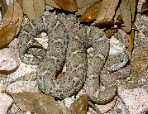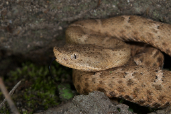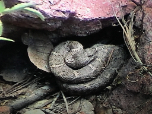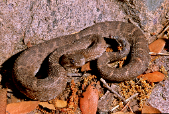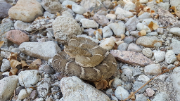New Mexico Ridge-Nosed Rattlesnake (Crotalus willardi obscurus)
Description: The color pattern consists of a gray or brownish gray ground color with scattered dark punctations. The facial stripes that are characteristic of this species may be completely absent. In the Sierra San Luis population, traces of the pale upper facial stripe may be visible on the posterior upper labials, but there is no pale stripe on the lower labials.
Habitat: They live primarily at high elevations in pine-oak woodlands, pine-fir forests, and pinyon-juniper woodlands. In the Animas Mountains, they are known to occur in areas of semi-evergreen oaks (Quercus sp.), conifers, and other tree-shrub combinations. The species is known to brumate in talus slides and will surface periodically for water on warm days.
v
Range: Found in the Animas and adjacent Peloncillo Mountains (Hidalgo County) in extreme southeastern Arizona and extreme southwestern New Mexico in the United States, and in the Sierra San Luis of extreme northwestern Chihuahua and extreme northeastern Sonora in Mexico. The type locality given is "one canyon in the Animas Mountains" (New Mexico, USA).
Found in these States:
AZ |
NM
Venom: Due to the generally small size of C. willardi, venom discharge yields are low; thus, the largely hemotoxic venom is not as life-threatening as that of other rattlesnakes. No documented deaths have been caused by ridge-nosed rattlesnakes, but pain and discomfort can still result from a rare bite.
Diet: The diet of the New Mexico Ridge-nosed rattlesnake was recently more thoroughly investigated. The principle diet of the ridge-nosed rattlesnake consists of rodents (Peromyscus spp.) and lizards (primarily Sceloporus spp.); although like some other small snakes, they do consume centipedes! Other incidental prey they have been recorded consuming includes birds and other small mammals.
Reproduction: Their gestation period is 13 months, at which point they give birth to live young.
Status: While globally this subspecies is listed as Species of Least Concern, Arizona has it listed as Imperiled and New Mexico has it listed as Critically Imperiled.
»» Kingdom: Animalia - Animals
»» Phylum: Chordata - Chordates
»» Subphylum: Vertebrata - Vertebrates
»» Class: Reptilia - Reptiles
»» Order: Squamata - Scaled Reptiles
»» Suborder: Serpentes
»» Clade: Colubroides
»» Family: Viperidae - Vipers
»» Genus: Crotalus
»» Species: Crotalus willardi - Ridge-Nosed Rattlesnake
»» Subspecies: Crotalus willardi obscurus - New Mexico Ridge-Nosed Rattlesnake
This article uses material from the Wikipedia article "Crotalus willardi obscurus", which is released under the Creative Commons Attribution-Share-Alike License 3.0. Content may have been omitted from the original, but no content has been changed or extended.
|




